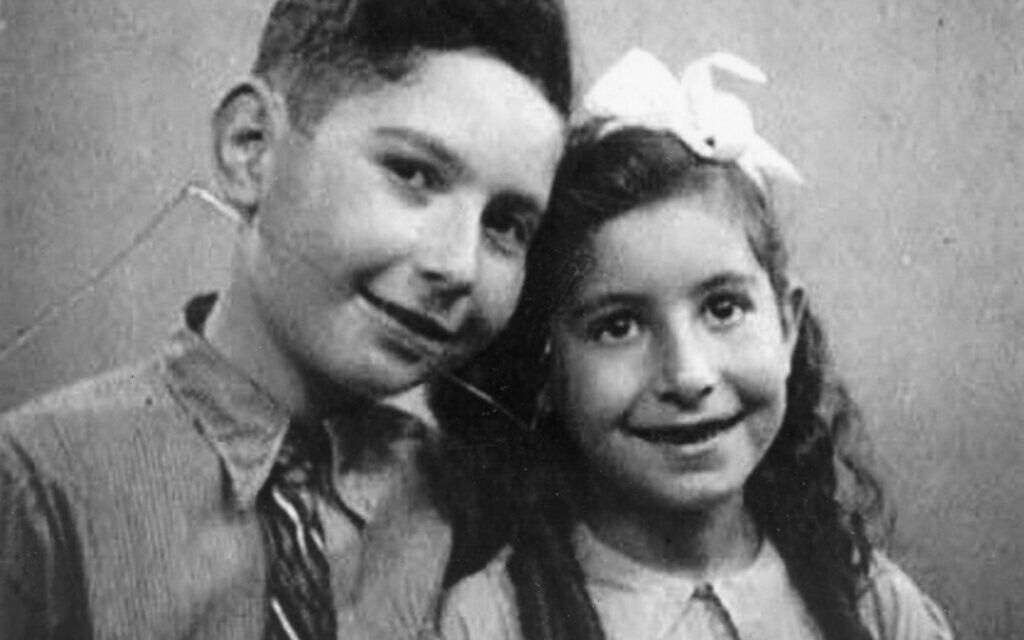Online exhibition by Yad Vashem open from January 27 highlights the accounts of 14 survivors who forged papers, pretending to be non-Jewish to survive the genocide

Henry Birnbaum never imagined that his grandmother’s ability to forge ink stamps on identity papers would eventually save him during the Holocaust.
Growing up in Antwerp, Belgium, Birnbaum led a religiously observant life with friends from Zionist youth groups. During the war, Birnbaum’s mother and aunt relied on false papers “doctored” by the boy’s grandmother that listed them as non-Jewish — including when Nazi officers attempted to arrest the family as Jews on two occasions.
“Once again, with two elderly, sick people in bed and the two children hiding terrified underneath, [Birnbaum’s mother and aunt] managed to convince the Germans, and they left empty-handed,” recounts a new exhibition at Yad Vashem, Israel’s Holocaust memorial and museum, entitled, “Remember Your New Name: Surviving the Holocaust under a False Identity.”
Birnbaum survived the war in Belgium by hiding with the aid of the amateurish papers inked by his grandmother. He is one of 14 survivors featured in the online exhibition released to coincide with International Holocaust Remembrance Day on January 27.
“Each of the stories is unique, but the common thread of the absolute terror of being found out to be Jewish is something that runs through all the stories,” said Amanda Smulowitz, a Yad Vashem researcher and the daughter of Birnbaum, who died last year.
“Remember Your New Name” is the newest of 150 online exhibitions in six languages curated by Yad Vashem. Artifacts in the permanent collection help bring the narratives to life, including this exhibition’s use of forged documents and the personal belongings of survivors.

“All of these artifacts make it personal and experiential,” Smulowitz said of the format. “We are trying to make accessible this material that a lot of people would not know about,” she told The Times of Israel.
Last year, after the death of her father, Smulowitz donated his original family photographs to Yad Vashem. Like many people who donate artifacts to Yad Vashem, Smulowitz and her family wanted Birnbaum’s photos to record for posterity a sense of what was erased in the Holocaust.
Although the topic of assumed identities and forged papers appears in the testimony of many survivors, this is the first time Yad Vashem curated an exhibition focusing on the experiences of Jews who survived under those circumstances.

“Some of the survivors featured are children who had to merge into new homes and surroundings in a foreign language,” said Smulowitz. “It is mind-boggling and unbelievable to read some of the accounts in the exhibition.”
‘No one could know that we were Jewish’
Another survivor included in “Remember Your Name” is Ida Krayz, who was born in Moldova in 1914. A trained musician, Krayz spent part of 1941 wandering between Ukrainian towns under an assumed identity to avoid capture.
“My bedding was the field and the forest,” said Krayz, who ran an orphanage before the war. “And my sustenance consisted of sorrow and lice.”
When Krayz returned home, she learned her family had been murdered at Babyn Yar outside Kyiv.

“The Germans took your mother and son to Babyn Yar! You know, 2,000 children were buried alive at Babyn Yar. The earth has been moving above those little ones for three days,” a neighbor told Krayz.
Not long afterwards, Krayz was captured by the Nazis and sent to a POW camp. There, she took on the name of Lidia Wladimirowna Tyszczenko to hide her Judaism.
After some time as a prisoner, Krayz managed to escape with the help of Russian partisans. She happily joined them in the forest where she could again live as herself.
“It was preferable to join the partisans,” Krayz recalled. “I did not intend to relinquish my life so easily.”

The circumstances under which Jews lived under false identities varied greatly, said Smulowitz. While some Jewish children were hidden “in plain sight” with adoptive families, other Jews lived fully in hiding and needed forged papers to obtain ration books for food.
“We try to convey what it really meant to live under a false identity during the Holocaust,” said Smulowitz. “It’s really not simple at all. Some people had to erase their previous identities and abandon everything familiar to them. Many children had to learn Christian prayers.”
One particularly compelling account in the exhibition is from survivor Brenda Pluczenik-Schor, who lived under a false identity in Budapest with her husband and daughters. At all times, the children had to be prepared to recite their new names and other information in case the Germans barged into the apartment.

“I often used to wake the children in the middle of the night, to check if they remembered their new names even when half asleep. I would repeat over and over again that no one could know that we were Jewish,” recounted Pluczenik-Schor in her memoir.
Pluczenik-Schor’s parents were murdered by the Nazis, but she and her husband and children survived the Holocaust with the help of forged papers.
As reported by The Times of Israel
